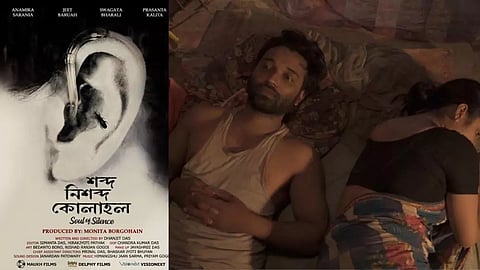

CHENNAI: ‘Soul of Silence’, (Xhobdo Nixhobdo Kolahal), an Assamese anthologly film that has three stories -- The Silence, The Sound, and The Dissonance directed by Dhanjit Das and produced by Monita Borgohain was screened on the 3rd day of the 20th Chennai International Film Festival, which began from 15th December till 22nd December 2022.
The poignantly affecting human drama is set around labour families and individuals from Assam and portrays the shades of human life with the key metaphor sound. "Sound is the main character of this film," says debutante theatre artiste-turned-actor Prasanta Kalita, who plays one of the protagonists of the film.
Speaking after the screening of the film, the director, Dhanjit Das talks to us about the film, how it was made, how he perceives the portrayal of patriarchy, and his view on the film's key metaphor 'sound'.
How does it feel to screen your film in the 20th Chennai International Film Festival?
It's actually amazing. It's an enthralling experience for me to see my film with a large audience. The list of films selected for this film festival is great and ours being part of it is truly special.
Your film is an anthology with three stories -- The Sound, The Silence, and The Dissonance. Ironically, the first story has no sound with few dialogues and the second story has more sound after he takes off his hearing device. Was it intentional?
Actually, it was the demand of the story. Everything should have a connection right? So, in the first story, we portrayed sound in a silent place. In the second one, we made it contrasting by showing it first silent, but suddenly the sound makes it clumsy and noisy. This set the silence part lively.
In the first story 'The Sound', why was the protagonist digging holes in the bamboo tree and what did you try to convey there?
There is an insect's sound reverberating in the film right? The insects lives inside the bamboo and the holes are done by them. She is trying to kill them. For the first time, she is not accepting the sound, then she started accepting it eventually.
In all three stories in your film, women characters had to suffer through the male gaze and patriarchy. How did you envision portraying patriarchy in rural areas in your film and how do you see the term?
It is a social structure we live in and how we had to live in for a long-time. It's about society in general. In our film also, we tried to bring in and reflect reality. Yes, I believe society is changing and we should hope so.
Did you already plan the film as an anthology while writing or wrote different stories and merge them into a single one?
Actually, the second story 'The Silence' is based on a real story of mine. I studied at a film Institute and then got this one. Two other stories came after that, so, I planned to make them altogether. All three stories have the same design and the same emotion and it connects very well. So, we planned to make it an Anthology.
Was your film inspired by the Tamil indie film 'Radiopetti' of Hari Vishwanath?
The protagonist in the second story was a good person, but was mentally unstable and people used to make fun of him. He actually liked it, he thought that the people are praising his work. My idea was to portray that If we don't understand the words, the whole world will be easy. Yes, just after completing the film. we saw 'Sound of Metal' which has the same theme. There are creative commons, maybe the way portrayed will be different.
All of these stories are shot in real locations with sync sound, right?
Only the first two stories were filmed with sync sound. The third story was a bit clumsy so we didn't do it in sync sound and we had to dub.
Did you intentionally place the metaphors in the film like clocks and lamps?
Yeah, it was intentional. I don't know how much people will find out (chuckling).
How were you able to convey the core themes to the actors and ask them to perform only on your set meter?
That was tricky. We shot the film during the COVID lockdown and the protagonist of the first story is actually my cousin sister. She is a theatre artist and we conducted some workshops and after that, we roped her in. In the second one, the protagonist is an actor and the other characters are laborers in the village and we had trained them. The third one is a mixed set of actors and village people. It was like three days of workshop and three days of the shoot continuously.
It's an Assamese and a Bengali film. The last story is of Bengali and it's about the migrated people from Bengal, who are socially ignored in society. We had to adopt their language and learn their lifestyle. As we don't have experience with their lifestyle, it took some time.
There were people clapping and appreciating the film, how does it feel?
It's a treat for us, When people like the film, it's just like a father seeing his son in the trials of his. So, yeah it was very honorable for me.
Visit news.dtnext.in to explore our interactive epaper!
Download the DT Next app for more exciting features!
Click here for iOS
Click here for Android